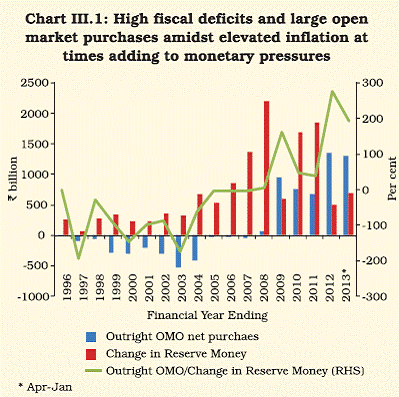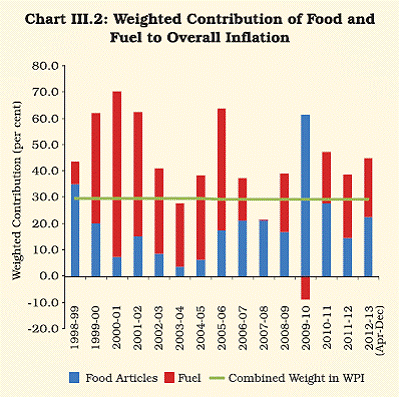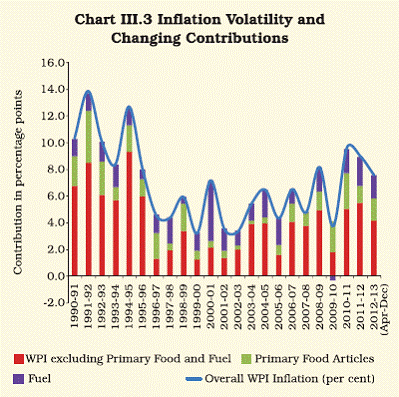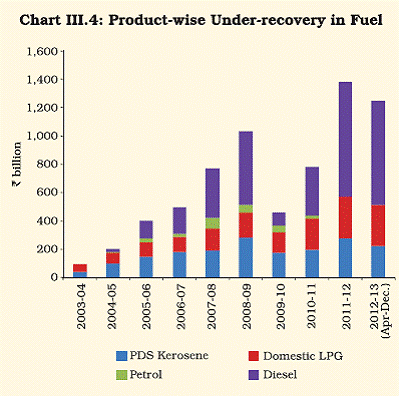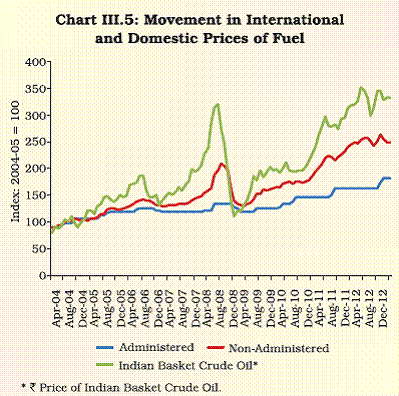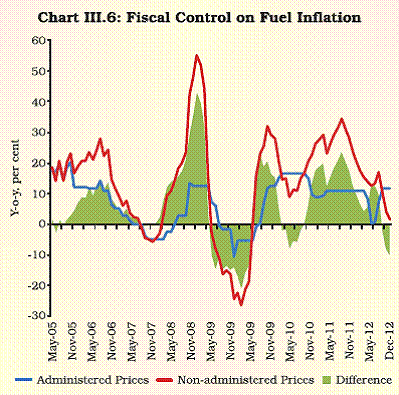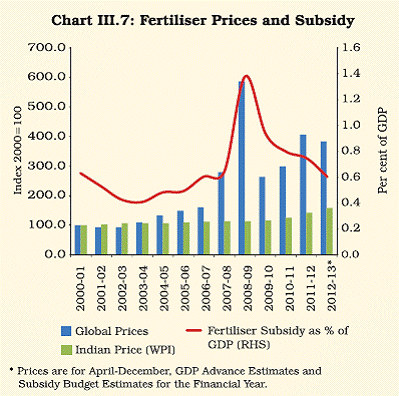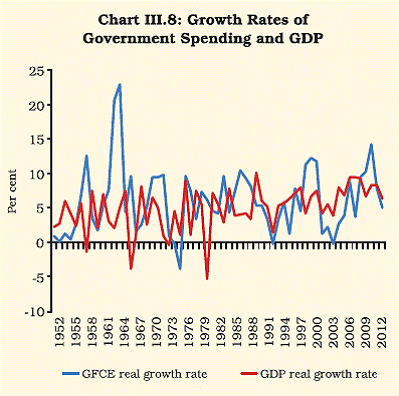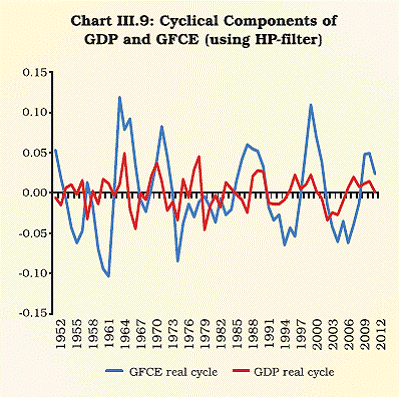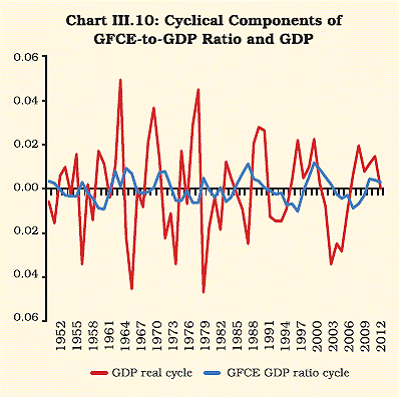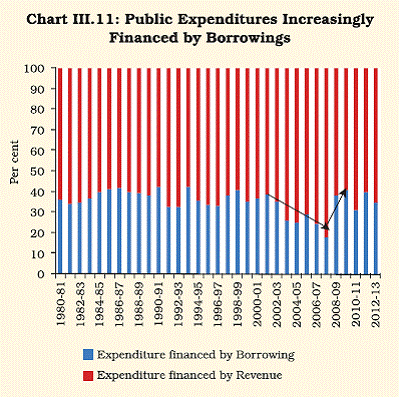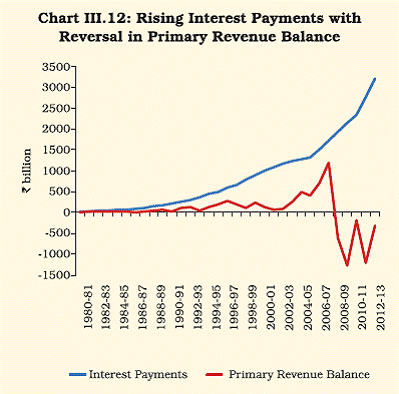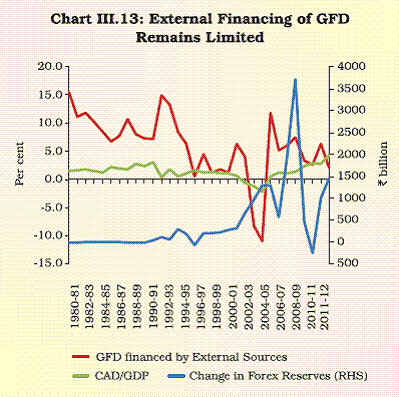III. Fiscal-Monetary Co-ordination in India : An Assessment - ربی - Reserve Bank of India
III. Fiscal-Monetary Co-ordination in India : An Assessment
Regime shifts, first from the automatic monetisation of fiscal deficits to limited monetisation and then to Fiscal Responsibility and Budget Management Act-led further curbing of monetisation, have considerably enhanced the degree of freedom for monetary policy setting in India. However, newer challenges have emerged for fiscal-monetary co-ordination under the new regime that requires attention on (i) the inflationary potential of large fiscal deficits even without conventional monetisation, (ii) pro-cyclicality of fiscal spending exerting demand management pressures on monetary policy and (iii) debt dynamics causing crowding out of private investment and impacting monetary management. Against this backdrop, there is a need for new fiscal rules and for reassessing the welfare costs of fiscal dominance of monetary policy. I. Introduction 3.1 This chapter provides an assessment of fiscal-monetary co-ordination in India, covering institutional developments and empirical trends and analysis. The evidence in the chapter suggests that while several institutional changes have helped bring about improved fiscal-monetary co-ordination and moderated the fiscal dominance of monetary policy, new challenges have surfaced that impinge on monetary policy efficacy. 3.2 Section II discusses how large fiscal deficits and consequent large market borrowings pose risks of monetisation of deficits in newer forms and may lead to a game-theoretic environment of sharing the burden of adjustment amongst fiscal and monetary authorities. Section III covers the evolution of fiscal-monetary co-ordination in different phases of institutional frameworks. Section IV focuses on fiscal and monetary policy co-ordination in inflation management. Section V analyses cyclicality in government expenditure and its implications for aggregate demand management. Section VI provides the empirical analysis on debt-deficit dynamics in India. Section VII summarises the policy implications of the analysis undertaken in the chapter, making a case for tighter but cyclically adjusted fiscal rules to further reduce fiscal dominance of the monetary policy in India. II. Fiscal Imperatives on Monetary Policy Fiscal dominance of monetary policy moderates but has not waned 3.3 Fiscal dominance of monetary policy has moderated in India as a result of a series of fiscal and monetary policy reforms undertaken over the past two decades. The most notable of these were (i) moving to a market-determined interest rate system by introducing auctions of government debt, (ii) phasing out of the automatic monetisation of fiscal deficits through the two Supplemental Agreements between the Government of India and the Reserve Bank of India, and (iii) curbing the monetisation of debt by enacting the Fiscal Responsibility and Budget Management (FRBM) Act, 2003 that prevented the Reserve Bank from subscribing to primary issuances of government securities from April 1, 2006. These landmark steps have considerably reduced the fiscal dominance of monetary policy. 3.4 During the same period, the Reserve Bank undertook far-reaching monetary reforms, moving from direct instruments to indirect instruments of monetary policy by developing market-based public debt markets. This, in turn, helped the economy step out of a regime of financial repression based on administered interest rates to vibrant money and debt markets that allowed interest rates to be largely determined by the market. The reforms pursued by the fiscal and monetary authorities in tandem helped improve the efficacy of macroeconomic management. However, newer challenges emerged. Large subsidies, especially for fuel, apart from adding to fiscal deficits limited the demand adjustments and spilled over to the current account. Large capital inflows financed the current account gap but the capital flow volatility added to interest rate and exchange rate pressures. At the same time, open market operations (OMO), though essentially a monetary tool, had to factor in the large market borrowing at times to maintain orderly financial conditions. In periods when inflation was high, this, in turn, added to pressures on monetary management. These require revisiting the issues relating to fiscal-monetary co-ordination with a view to explore further changes in the broad framework provided by the institutional and legal arrangements, as well as instruments and practices. The changes should help improve the efficacy of monetary and fiscal policies by bringing about independence, accountability and greater co-ordination. 3.5 On the one hand, there has been a regime shift from the days of financial repression. The automatic monetisation of debt has been phased out. On the other, fiscal dominance of monetary policy remains through high fiscal deficits and administered price mechanisms or price rigidities in the pricing of utilities despite big steps taken towards reducing it. The conceptual debate on what constitute monetisation of debt is discussed in Box III.1. Box III.1 Monetisation of debt is a difficult concept to comprehend, as it is not clearly defined. It can occur through several practices that may be transparent, translucent, opaque or hidden. For long, monetisation of debt was understood as “converting government debt to money” or “the central bank’s purchase of government bonds when they are issued”. Either definition has its problems. Typically, the government can finance its deficits by printing money or issuing debt. The former directly attenuates monetary control. In the modern world, with central banks in charge of controlling the aggregate money supply, governments typically finance their deficits by issuing government bonds. They can either be purchased by the public from the existing supply of money or by central banks by increasing the monetary base, and hence the money supply. The key question is whether any purchase of government securities by the central bank would tantamount to monetisation of debt. Central banks, conducting monetary policy through open market operations, purchase (or sell) securities to infuse (or absorb) liquidity. They do so to adjust the monetary base and/or the interest rates in line with their targets. These operations are often conducted on a day-to-day basis, sometimes more than once a day. So, if mere purchase of government securities by the central bank is seen as monetisation, almost all central banks do it almost all the time. So, does monetisation reflect the central bank’s purchase of government securities in primary but not secondary markets? This distinction would only work as long as central banks do not indulge in open market purchases to support the government’s debt financing. If the central banks go on infusing liquidity to support the banking sector’s purchases of government bonds even while not subscribing to its primary issuances, the net result would be the monetisation of debt. Central bank purchases of government securities expand the monetary base, but the finer distinction for monetisation is whether such purchases are in support of government debt operations. In practice, it is still hard to make a black-and-white distinction between what portion of the central bank’s purchases of government securities is for the purpose of the conduct of monetary policy and what proportion is in support of government’s borrowings. The key to this judgment lies in central bank’s purchases of government bonds being in alignment with its target of base money and money supply expansion. These targets should be set independently of debt management considerations. In practice, many central banks today do not target monetary aggregates. They instead rely on interest rate targeting and operate on the short-term policy rate – typically, the overnight rate or a 14-day repo rate. They exercise control over bank reserves and interest rates through open market operations that are conducted both through repo operations and outright sales/ purchases at the longer end of maturity. This is particularly true in the case of quantitative easing. Consequently, monetisation of some form can occur by impacting the yield curve. Reference Thornton, Daniel S. (2010), “Monetising the Debt”, Economic Synopses No.14, Federal Reserve Bank of St. Louis. 3.6 Although the enactment of the FRBM Act, 2003 has prohibited the Reserve Bank from participating in primary issuances of government securities, it is evident that large fiscal deficits can potentially lead to some form of monetisation of debt. This is more important if large borrowings crowd out private credit and compel monetary authorities to provide greater liquidity through open market purchase of government bonds. This attenuates monetary policy efficacy (Chart III.I). 3.7 India has made rapid strides towards phasing out the monetisation of debt. For long, government deficits were automatically monetised through the issuance of ad hoc treasury bills. These bills of 91-day maturity were non-marketable instruments that were automatically issued to the Reserve Bank to replenish the central government’s cash balances with it to meet the government deficit. This problem of automatic monetisation was in addition to the financial repression caused by issuances of 91-day treasury bills “on tap” (at a fixed discount of 4.6 per cent per annum), which were taken up mainly by banks for short-term investment or to comply with the requirements of maintaining the Statutory Liquidity Ratio (SLR). Financing government expenditure by issuing ad hoc treasury bills to the Reserve Bank caused an increase in the reserve money. In addition, the Reserve Bank also rediscounted the tap treasury bills subscribed to by the banks, thus adding to the monetisation. Recent measures to reduce monetisation of debt in India are discussed in Box III.2. 3.8 Fiscal dominance of monetary policy goes beyond the monetisation issue. It occurs in several forms. Large fiscal deficits have inflationary consequences even when they are not financed by the central bank. For instance, suppressed inflation remains a significant drag on inflation management even after the government has taken some steps to deregulate administered prices in the energy sector. At the first stage, suppressed inflation feeds into inflation as the subsidies necessitated by the price rigidity widen the fiscal deficit. At the second stage, as subsidies become unsustainable, they sooner or later necessitate large discrete price adjustment that feeds into inflation expectations. At the current juncture, if prices are adjusted in one go to remove total under-recovery of the oil marketing companies and prices of coal and electricity are adjusted upwards by a moderate 10 per cent each, the direct impact would increase wholesale price index (WPI) by 4 per cent. This suggests the persistence of fiscal dominance of monetary policy. In terms of the Fiscal Theory of Price Level (FTPL), fiscal dominance occurs in a weak or a strong form. In the weak form, fiscal dominance occurs when money growth rises to accommodate fiscal deficit and so exerts upward pressure on inflation. In the strong form, even if the level of money supply does not change in response to the fiscal gap, the latter independently raises the level of inflation because of its impact through aggregate demand. The weak form suggests that a central bank cannot target inflation because it cannot control money supply under the fiscal dominance. The strong form implies that inflation is not necessarily a monetary phenomenon and fiscal policy instead drives inflation. Box III.2 Since the late 1980s, several steps were taken to reduce the fiscal dominance of monetary policy. First, the Reserve Bank and the government moved to establishing a market-based public debt market. Auctions of 182-day treasury bills was introduced from November 1986, 364-day treasury bills from April 1992, and 91-day treasury bills from January 1993. As auction-based yields were higher, an increasing part of the government borrowings came to be financed through market sources, enabling a better control of reserve money by the Reserve Bank. Second, two Supplemental Agreements were signed between the Reserve Bank and the Government of India. The first, signed on September 9, 1994, limited the creation of ad hoc treasury bills during the three-year period ending 1996-97. The net issue of ad hoc treasury bills was capped on an end-year basis. Also, it was agreed that if it exceeded the stipulated limit for 10 consecutive working days during the year, the Reserve Bank would automatically reduce the excess by auctioning the treasury bills or dated securities. The Second Supplemental Agreement signed on March 6, 1997 completely phased out funding through ad hoc treasury bills and the outstanding amount of treasury bills as at end-March 1997 was converted into special undated securities at a yield of 4.6 per cent. A system of Ways and Means Advances (WMA) was put in place from April 1, 1997. Under the WMA system, the Reserve Bank has been extending short-term advances up to the pre-announced half-yearly limits, fully payable within three months. The Government of India has also been allowed to incur an overdraft but at an interest rate higher than that of the WMA. Effective April 1, 1999, the overdraft has been restricted to a maximum period of 10 working days. Further, it was agreed that the Reserve Bank would trigger fresh floatation of government securities whenever 75 per cent of the WMA limit was reached. It was also agreed that the government’s surplus cash balances with the Reserve Bank, beyond an agreed level would be invested in governments own securities. Even after a cessation of automatic monetisation of debt through termination of the ad hoc treasury bills, monetisation continued in another form. The Reserve Bank continued to subscribe to the primary issuances of public debt as a result of devolvement of auctions on the Reserve Bank as the underwriting capacity of the primary dealers (PDs) was limited. As such, the third major step towards phasing out the monetisation of debt was taken with the enactment of the FRBM Act, 2003 that barred the Reserve Bank from subscribing to the primary issuances of the government from April 1, 2006. Has the monetisation been completely phased out in India now that the Reserve Bank no longer subscribes to the primary issuances in government auctions? De-facto monetisation has been considerably phased out, but not completely. As long as fiscal deficits remain large, the size of market borrowings would also remain large and impinge upon the conduct of monetary policy, no matter how the debt management is conducted. The size of the government’s net market borrowing programme (dated securities) increased nearly 9.7 times in eight years to `4.9 trillion in 2012-13. In addition, the government resorted to an additional funding of `1.16 trillion through 364- day treasury bills. During this period, the Reserve Bank conducted large net open market purchases that included `945 billion in 2008-09, `755 billion in 2009-10, `672 billion in 2010-11 and `1.3 trillion each in 2011-12 and 2012-13 (untill January). While in principle the Reserve Bank uses open market operations to impact liquidity and monetary conditions, in practice it is not easy to decipher what part of the open market operations were undertaken purely on these very considerations and what part might have been influenced by the consideration that large government borrowing may not be market disruptive. During 2008- 09, OMOs were in sync with monetary policy easing undertaken in that year on the back of the global financial crisis. However, between March 2010 and October 2011 monetary policy was clearly in a tightening mode. Whether OMO purchases in this period attenuated monetary policy efficacy could be a matter of debate and research. On balance, OMO purchases undertaken since 2009-10 have not resulted in monetary expansion beyond what was envisaged under the monetary policy. OMO purchases during this period, by and large served both monetary policy and debt management objectives. For instance, during 2011-12 the government did aditional market borrowings of nearly `2 trillion (including treasury bills) over the budgeted amount, while the central bank needed to create reserve money to ease the tight liquidity situation. OMOs also helped to reduce the liquidity tightness arising out of foreign exchange market intervention by the Reserve Bank. During 2012-13, however, with the interest rate cycle reversing, high government borrowing, through its impact on yield, may have weakened the transmission of lower policy rates to other segments of the financial markets. Therefore, the sheer amount of borrowings could still put pressures on monetary policy. Further, during 2008-09 when monetary and fiscal policies acted in tandem to meet the extraordinary challenge posed by the global financial crisis, monetisation of debt also occurred through Special Market Operations (SMOs) conducted by the Reserve Bank. The SMOs, introduced in June 2008, enabled public sector oil marketing companies to sell oil bonds to the Reserve Bank to raise foreign exchange. These SMOs, de facto, weakened the FRBM Act regime as it indirectly monetised government deficits in two steps. First, the government by issuing oil bonds understated the true fiscal deficit. Second, if the government was to fund it through its own dated securities, the Reserve Bank could not have subscribed to it in primary issuances. However, as oil bonds lacked liquidity, the Reserve Bank stepped in to provide the same, while also resolving the dollar funding requirements of the oil companies. This innovative instrument helped minimise the pressure on interest rates as well as exchange rates. While SMOs were small in size, they helped serve the crisis management objectives. Large government borrowing and large open market purchases, however, at times pose a macroeconomic challenge to the extent that they could lead to monetisation of debt. References Rangarajan, C. (2007), “Indian Banking System: Challenges Ahead”, First R.K. Talwar Memorial Lecture, Indian Institute of Banking and Finance, July 31, 2007. III. Interaction between fiscal and monetary policy under different regimes 3.9 Fiscal and monetary policy interactions have evolved over the past three decades in accordance with the frameworks adopted for fiscal and monetary policies. Based on these frameworks, the following five broad phases may be identified. Phase I: High fiscal dominance from 1980-81 to 1990-91 3.10 The decade of the 1980s saw excessive deficits. The Centre’s gross fiscal deficit (GFD)/GDP ratio averaged 6.7 per cent, which was markedly higher than the average of 3.8 per cent for the 1970s. The states’ fiscal position also deteriorated with their average GFD/GDP ratio widening to 2.8 per cent from 2.0 per cent during the same period. Other deficit indicators worsened as well. The fiscal slippage was more from the centre’s side and mainly originated from its revenue expenditure side. Both tax and non-tax revenues as well as capital receipts showed some improvement, but capital spending remained constrained. The fiscal deterioration placed a large burden on monetary policy, with ad hoc treasury bills turning out to be the route for automatic monetisation of fiscal deficits, thus limiting central bank autonomy for achieving monetary policy objectives. 3.11 Net Reserve Bank credit to the government expanded at a rapid pace in the 1980s. This was a direct consequence of the monetary accommodation of high fiscal deficits in the 1980s. Reserve Bank monetised deficits through ad hoc treasury bills. This resulted in a sharp accretion in Net Domestic Assets (NDAs). Monetary pressures were felt as a consequence despite a sharp deceleration in Net Foreign Assets (NFAs). Currency with the public continued to see a secular decline, but the expansion in NDAs came increasingly out of the net Reserve Bank credit to the government. After two oil price shocks, inflation did moderate until 1985- 86, but returned later on the back of large fiscal expansion that could not be countered by monetary contraction. 3.12 During the period, a regime shift in monetary policy occurred with the decision to move from credit budgeting to monetary targeting. Following the Report of the Committee to Review the Working of the Monetary System (Chairman: Prof. Sukhamoy Chakravarty, 1985), the Reserve Bank introduced monetary targeting in the mid-1980s. However, the credit budgeting framework of direct allocation of credit prevailed for most of the period. During this period, the Reserve Bank announced its credit policy twice during a fiscal year following periodic credit budget meetings with the commercial banks. The Reserve Bank indicated the broad guidelines for deposit and credit growth, as also credit deployment, to major scheduled commercial banks (SCBs) after assessing macroeconomic aggregates such as growth and inflation. 3.13 Fiscal dominance of monetary policy turned out to be a binding constraint for monetary policy during this period. The Reserve Bank provided liquidity to smoothen temporary mismatches between sources and uses of funds of the government and repeatedly expressed concern about the link between fiscal deficit and excess liquidity creation. The Chakravarty Committee Report, which prompted the government to widen the definition of ‘budget deficit’ so as to better reflect the monetisation of the budgetary deficit, also expressed similar concerns. The acceptance of the wider concept of budget deficit was a major step towards greater co-ordination between the fiscal and monetary policies. The Committee, while recommending the adoption of monetary targeting, noted that the interrelationships among output, money and prices are subject to complex lags and that it is difficult to set out the precise operations of these lags. As such, the link between money, output and prices cannot be viewed exclusively within the narrow time-frame of one year. 3.14 The transition to monetary targeting was phased in only during the 1990s. No specific monetary target was set during 1985-90 except for fixing a credit ceiling linked to the average M3 growth in the previous year(s). As such, credit budgeting continued to be the broad framework for moderating monetary growth, but targets were generally overshot, since the private sector required credit support in the face of the large draft of the government on household savings. Credit policies during the period were largely contractionary, but their efficacy was dampened by the need to maintain orderly conditions in the debt market. 3.15 The Reserve Bank juggled with the Cash Reserve Ratio (CRR) as well as the Statutory Liquidity ratio (SLR) and selective credit controls to serve the conflicting interests of monetary control and to meet large credit requirements. The CRR reached its statutory ceiling of 15 per cent in 1989. The Reserve Bank resorted to additional CRR on incremental net demand and time liabilities (NDTL) on various occasions until 1992. The Reserve Bank also used administered interest rates – deposit and lending rates – to conduct monetary and credit policy. 3.16 A monetary policy framework based on an explicit monetary targeting regime was adopted only in 1991-92, when a real GDP growth of 3 to 3.5 per cent, an inflation rate of not more than 9 per cent, and a significant slowdown in M3 expansion to about 13 per cent was envisaged. Monetary targets so set were overshot by a wide margin, with M3 growth turning out to be 19.3 per cent. Monetary targeting for 1992-93 was based on the underlying assumption of reduction of the monetised deficit (net Reserve Bank credit to the central government) which was “consistent with the government’s declared objective of reducing the gross fiscal deficit from 6.5 per cent of GDP in 1991-92 to 5.0 per cent in 1992-93”. 3.17 Credit budgeting in India was not very successful in the face of large fiscal dominance. It ended up generating financial repression that kept real interest rates low and disincentivised both savings and investments. As a result, the economy witnessed lower growth while inflation shot up. Phase II: Exit from financial repression from 1991-92 to 2002-03 3.18 The second phase saw financial sector reforms. It was marked by a gradual development of market-based instruments to finance government debt. The blueprint for these reforms was laid by the Report of the Working Group on the Money Market (Chairman: N. Vaghul) in 1987 and the Report of the Narasimham Committee I, 1991. Several steps were taken over a period of time. These included the development of money market instruments, the introduction of auctions of Government of India (GOI) treasury bills, a reduction in statutory pre-emptions through CRR and SLR and partial deregulation of interest rates. Although 182-day T-bill auctions were introduced in November 1986, the price discovery at the short-end could improve only after the introduction of 364-day treasury bills in April 1992 and the extension of the auction system to 91-day treasury bills in January 1993. These policy initiatives together with the two Supplemental Agreements (Box III.2) enabled a sizeable reduction in monetisation of deficits, which helped to moderate the fiscal dominance of monetary policy. 3.19 During this period, monetary targeting was actively pursued. M3 growth targets witnessed a secular decline. The financial sector reforms during this period, especially the development of an active secondary market for government securities, laid the foundation for moving from direct to indirect instruments of monetary control in the medium-term. The statutory pre-emptions for banks were reduced from around 63 per cent in early 1992 to 35 per cent in a span of six years. The interest rate structure was rationalised and term deposit rates were deregulated. 3.20 The period was marked by a distinct lowering of fiscal deficits until 1996-97. Around the same time, the credit compression of 1995-96 contributed to economy slowing down beyond what was envisaged. This resulted in both monetary and fiscal policies facing unforeseen difficulties. Monetary policy did ensure a substantial decline in inflation in 1995-96, but with broad money growth decelerating to below trend, there were persistent costs for the real economy. Though fiscal-monetary co-ordination improved during the period, there were spells, especially during the credit crunch of 1995-96, when greater co-ordinated action may have yielded better results. Phase III: Fiscal and monetary prudence from 2003-04 to 2007-08 3.21 The financial sector reforms enabled the Reserve Bank to shift from direct instruments to indirect instruments of monetary control and the period 2003-04 to 2007-08, as a result, was marked by a regime shift. Simultaneously, fiscal reforms were undertaken at an unprecedented pace with the enactment of the FRBM Act, 2003. These policy initiatives taken together helped to significantly lower the fiscal dominance of monetary policy. At the same time, surge in capital inflows during this period, posed challenges for macroeconomic management. The Reserve Bank resorted to large OMOs to absorb surplus liquidity so as to sterilise capital inflows. In fact, OMOs were in liquidity absorption mode through the second half of the 1990s and into the early 2000s. 3.22 The most critical reform that enabled an improvement in the operating procedures for the conduct of monetary policy related to the introduction of the Liquidity Adjustment Facility (LAF) in phases. In 1998, the Committee on Banking Sector Reforms (Narasimham Committee II) recommended the introduction of LAF, under which the Reserve Bank would conduct auctions periodically, if not necessarily daily. The Committee envisaged that the Reserve Bank could reset its repo and reverse repo rates, which would provide a reasonable corridor for the call money rates. In pursuance of these recommendations, the Reserve Bank introduced an Interim Liquidity Adjustment Facility (ILAF) to conduct repos and reverse repos, which replaced the general refinance facility. The ILAF helped reduce fluctuations in the money market rates. In June 2000, the ILAF was replaced by LAF with variable rate repo auctions. In April 2003, the multiplicity of rates at which liquidity was being absorbed/injected under the back-stop facility was rationalised. These changes enabled the Reserve Bank to use LAF as a principal tool for effecting changes in liquidity at the margin and to conduct monetary policy by using the indirect tool of LAF, inter alia, by setting repo/reverse repo rates. 3.23 The FRBM Act, which was enacted on August 26, 2003 and came into force from July 5, 2004, unleashed a regime of fiscal rules to restrain discretionary policies that tend to have an inherent deficit bias. The move was prompted by international experience that showed that several countries facing huge fiscal imbalances had gained through similar legislations and rules such as the Medium-Term Financial Strategy in the UK, the Gramm Rudman Hollings Act of 1985 in the US, and the fiscal responsibility legislations in New Zealand in 1994, Argentina in 1999, Peru in 1999 and Brazil in 2002. 3.24 The Act stipulated that the central government should take appropriate measures to reduce the fiscal deficit and eliminate the revenue deficit by March 31, 2008 and thereafter build up adequate revenue surplus. The Union Budget for 2004-05, however, deferred the target for eliminating the revenue deficit to 2008-09. The Act also prohibited direct borrowings by the Centre from the Reserve Bank from 2006-07 except through Ways and Means Advances (WMAs) to meet temporary mismatches in receipts and payments or under exceptional circumstances. 3.25 In exercising the powers conferred by the FRBM Act, 2003, the central government framed the ‘Fiscal Responsibility and Budget Management Rules, 2004’, effective from July 5, 2004. Under these rules, annual targets were set for the phased reduction in key deficit indicators over the period ending March 31, 2008. The rules also imposed annual ceilings on government guarantees and additional liabilities. 3.26 Fiscal-monetary policy co-ordination also received a fillip from the Debt Swap Scheme (DSS), which was recommended by the Finance Commission. It enabled the state governments to substitute their high-cost loans from the centre with fresh market borrowings and a portion of small saving transfers. Under the scheme, the states swapped high-cost loans. During 2002-03 to 2004- 05, states swapped `1.02 trillion of their debt with the central government. They financed this through additional market borrowings of `536 billion or 53 per cent at interest rates below 6.5 per cent and the remainder through the issue of special securities to the National Small Savings Fund (NSSF) with the interest rate fixed at 9.5 per cent. Though the scheme was debt-neutral, it brought about long-term benefits in lowering the cost of servicing debt for the state governments. 3.27 Another example of fiscal-monetary co-ordination in this period came in the form of introduction of the Market Stabilisation Scheme (MSS). The scheme aimed at improving monetary policy that was expected to lose its efficacy in the face of paucity of instruments to sterilise liquidity arising from large capital inflows that required intervention in the foreign exchange markets. The initial burden of sterilisation was borne by the outright transactions involving the sale of dated securities and treasury bills. However, due to the depletion in the stock of government securities, the burden of liquidity adjustment shifted to LAF. The LAF was essentially designed to handle marginal liquidity surpluses/deficits. For absorbing the liquidity of a more enduring nature, the MSS was conceived. 3.28 The Government of India and the Reserve Bank signed a Memorandum of Understanding (MoU) on March 25, 2004 and the MSS scheme was launched on April 1, 2004. Under the MSS, treasury bills and dated securities were issued by the government. The proceeds of the MSS were sequestered by holding them for the government in a separate identifiable cash account maintained and operated by the Reserve Bank. The amounts credited into the MSS account could be appropriated only for the purpose of redemption and/or buy-back of the treasury bills and/or dated securities issued under the MSS. MSS securities were treated as eligible securities for the SLR, repo and LAF. 3.29 A large number of countries, such as Chile, China, Colombia, Indonesia, Korea, Malaysia, Peru, Philippines, Russia, Sri Lanka, Taiwan and Thailand have issued central bank securities. However, the central banks of many of these countries faced deterioration in their balance sheets. As such, the MSS considerably enhanced the degree of freedom for monetary policy. It strengthened the Reserve Bank’s ability to conduct exchange rate and monetary management operations. It also enabled the Reserve Bank to use the MSS tool flexibly to both absorb and impart liquidity later when needed. Phase IV: Co-ordinated and unco-ordinated responses from 2008-09: 3.30 The last phase starting 2008-09 is an interesting one. On the one hand, it witnessed a high degree of co-ordinated fiscal-monetary policy response in the face of the contagion from the global financial crisis and the resultant slowdown of the global economy. Fiscal and monetary policies provided a co-ordinated stimulus to counter the sudden loss of confidence that could have rapidly caused a downward spiral in the domestic economy. Following the collapse of Lehman Brothers, the Reserve Bank announced a slew of monetary and liquidity easing measures from October 2008 to January 2009. For example, in a co-ordinated move in early December 2008, the fiscal authorities simultaneously announced a package that included an across-the-board 4-percentage points cut in central VAT for non-petroleum products, a support package to Micro, Small and Medium Enterprises (MSMEs), sops to exporters, and permission for India Infrastructure Finance Company Limited (IIFCL) to raise `100 billion (about US$2 billion) through tax-free bonds. The Reserve Bank’s steps included a 100 basis points cut in its policy rates and an additional refinance package of `110 billion. 3.31 The fiscal-monetary co-ordination in the aftermath of the global financial crisis was accompanied by less co-ordination on how the fallout of the stimulus might be handled. As a result, there were some un-co-ordinated responses during the period of exit from the stimulus. An underfunded budget and the fiscal stimulus of 2008-09 left awry the budgeting mathematics during the year. Net market borrowings more than doubled from the initial estimates, providing a setting for a ‘game of chicken’ to be played between the fiscal and monetary authorities (Box III.3). Box III.3 Monetary and fiscal policies need co-ordination for macroeconomic management. In practice, this co-ordination sometimes brings about a game-theoretic environment in which fiscal and monetary authorities face a two-person non-co-operative game. Following Buiter (2010)’s description of ‘Game of Chicken’ used to analyse the interaction of the central bank and the Treasury in the euro area, there has been a recognition that central banks and fiscal authorities often test each other to see who blinks first and makes the required adjustment to accommodate the other. In the game of chicken, also known as the hawk-dove or snowdrift game, each player prefers not to yield to the other and the worst possible outcome occurs when both players do not yield. An easy real life situation to understand this game is when two car drivers are headed on a collision course. One of the drivers must swerve to avoid a crash that could kill both, but if one driver swerves he is called “chicken” or a coward. In terms of payoffs, the loss from swerving (or being called “chicken”) is trivial compared to the huge loss to both in the case of a crash. A typical pay-off example is:
The pure strategy equilibriums are ones in which one player swerves and the other does not. But in the absence of co-ordination, neither can know if the other one will swerve and a reasonable strategy, therefore, would be to swerve before a fatal crash. But if one believes one’s opponent is reasonable, one may decide not to swerve at all, ending up in the worst Nash-type outcome. An oft-cited example of the game of chicken has been the current strategic interaction between the European Central Bank (ECB) and the several national fiscal authorities in the euro area. The ECB by law is mandated to seek price stability and pursue any other objective, if and only if, it does not conflict with its prime objective of price stability. However, with fiscal authorities, in some of its member countries, facing a sovereign debt crisis, ensuring solvency has become one of its proximate goals, if not an explicit one. The ECB knew that a sovereign default in any of the PIIGS (Portugal, Ireland, Italy, Greece, and Spain) could spark uncontrollable contagion, posing financial stability and growth risks that would be difficult to manage. The ECB is seen to want price and financial stability, while fiscal governments are perceived to want ECB financing to avoid default on government debt. The fiscal authorities may encourage the ECB to undertake quasi-fiscal activities by taking sovereign and private credit risk on its balance sheet. However, the ECB’s concern is that any quantitative easing (QE) it undertakes should be non-inflationary. The ECB has a monopoly in supplying base money and so the seigniorage benefits at least initially are appropriated by it. However, monetisation of public debt may have occurred in some form as a result of the ECB’s 3-year Long-term Repo Operations (LTRO) since December 2011. Even before the onset of the global financial crisis, Buiter and Sibert (2005) proposed a radical change in the operating procedures of the ECB aimed at restoring market discipline and tackling unsustainable fiscal deficits. The ECB was seen as trying to restore a first-mover advantage in the game of chicken. The ‘Fiscal Theory of Price Level (FTPL)’ suggests that fiscal deficits may or may not lead to high inflation depending on whether there is fiscal dominance or monetary dominance in this game of chicken. In the case of fiscal dominance, runaway deficit increases, which eventually forces the central bank to blink and to monetise the deficit, i.e. to increase seigniorage and use the inflation tax to finance an exogenous fiscal deficit path. If there is monetary dominance, the central bank commits not to monetise the fiscal deficits and then the fiscal authority is forced to blink and adjust its budgetary policy by cutting spending or raising taxes to satisfy its inter-temporal budget constraint. If neither authority blinks, the default risk increases as interest rates go higher and the debt dynamics worsens. The FTPL offers a resolution of Sargent and Wallace’s (1981) unpleasant monetarist mathematics that provides a setting for the game of chicken in macroeconomic management. In a seminal 1981 paper titled, “Some unpleasant monetarist arithmetic”, they show that even if inflation in the short-run is a monetary phenomenon, it remains a fiscal phenomenon in the long-run. This follows from the government budget constraints and the limits to public debt that can be held by the private sector. Together, these ensure that in the long-run, the growth of money stock is governed by the fiscal deficit as fiscal authorities act as Stackelberg leaders, while monetary authorities act as Stackelberg followers. The Stackelberg model is a strategic game in economics in which the leader firm moves first while the follower firms move sequentially, and it offers a solution to well-known price determinacy puzzles. More fundamentally, the FTPL suggests that the consolidated government present value budget constraint is an optimality condition, rather than a constraint on government behaviour and it shows how Ricardian and non-Ricardian notions of wealth effects play a role in price determination and household consumption. Strong forms of the FTPL suggest strange cases where this no-blink twosided game leads to a jump of the initial price level (high inflation) to ensure that the government’s inter-temporal budget constraint is satisfied. In a real world, in the game of chicken, generally fiscal dominance is a rule and monetary dominance turns out to be the exception. India is not unique to this general rule. Large fiscal deficits have at times caused ‘game of chicken’- like situations. If the central bank pursues its monetary objectives by not accommodating the debt financing in its strategy calculations, the macroeconomic outcome may be inferior for both the fiscal and monetary authorities, as well as for the economy as a whole. As such, macroeconomic management has to be conducted keeping the compulsion to avoid disastrous consequences. References Buiter, Williams and Anne C. Sibert (2005), “How the Eurosystem’s Treatment of Collateral in its Open Market Operations Weakens Fiscal discipline in the Eurozone (and What to Do About it)”, Conference ‘Fiscal Policy and the Road to the Euro’, organised by the National Bank of Poland and the Central Bank of Hungary in Warsaw, June 30 - July 1, 2005. Libich, Jan, Dat Thanh Nguyen and Petr Stehlik (2011), “Monetary Exit Strategy and Fiscal Spillovers”, CAMA Working Paper 4/2011, Australian National University Rapoport, A. and A.M. Chammah (1966), “The Game of Chicken”, American Behavioral Scientist, 10. Sargent, T. and N. Wallace (1981), “Some Unpleasant Monetarist Arithmetic”, Federal Reserve Bank of Minneapolis, Quarterly Review 1–17. 3.32 Fiscal dominance has, however, been reduced in India considerably by adopting a co-operative framework with a view to minimise ‘game of chicken’ situations. The Supplemental Agreements, the FRBM Act, the Finance Commission reports, and the Market Stabilisation Scheme (MSS) are all examples that have contributed to developing co-operative strategies for fiscal-monetary policy interactions. Often both the authorities have formally or informally discussed their plans with one another and/or signalled their intentions convincingly before a ‘game of chicken’ situation develops. Credible signalling is a useful strategy to further co-ordination. For fiscal authorities, the fiscal rules are the best form of credible signalling for swerving. However, these rules have been reneged upon in events of stress or due to political cycles. 3.33 The year 2008-09 proved to be one example when the Union government ended up with a GFD/ GDP of 6.0 per cent against the budgeted deficit of 2.5 per cent and the net market borrowings turned out to be `2.34 trillion against the budgeted level of `1 trillion. The fiscal slippage was unprecedented. Fiscal authorities did not clearly signal such slippage early on and the sudden large extra market borrowings in the last quarter resulted in 10-year benchmark yield that had fallen to 5.0 per cent at end-December 2008 to rise by 200 basis points to 7.0 per cent by end-March 2009. This was in spite of the Reserve Bank undertaking outright open market purchases of about `890 billion in the last quarter of 2008-09 to avert a possible interest rate shock at a time when monetary policy resorted to unprecedented easing. 3.34 During 2009-10, the GFD-GDP ratio turned out to be 6.4 per cent against the budgeted deficit of 6.5 per cent. The net market borrowings were `3.98 trillion, in line with the budgeted amount. In contrast, in the year 2010-11, the government had a one-off revenue windfall through spectrum auctions and divestments that helped in temporary fiscal consolidation. As a result, the GFD-GDP ratio fell to 4.6 per cent, which was well below the budgeted level of 5.5 per cent. The year 2011-12 saw again a fiscal slippage of 1.3 percentage points from the budgeted level of 4.6 per cent. At the start of the year, the central bank was credibly committed to maintaining tight monetary policy, but extra market borrowings of around `2 trillion (including treasury bills) put some upward pressure. However, liquidity tightened excessively due to several factors, including the RBI’s foreign exchange intervention to check volatility in the market since August 2011. OMO purchases were, therefore, to a large extent in sync with the central bank’s objective of reduction in excessively tight liquidity conditions. Avoiding a game of chicken could best be pursued with tighter fiscal and monetary policy rules and credible commitment to these rules. These rules should have some in-built flexibility to meet cyclicality – economic as well as political – but could avoid widening of structural deficits. 3.35 The exit from stimulus was far less co-ordinated than the provision of the stimulus. The CENVAT roll-back was deferred, putting added pressures of monetisation of debt on monetary policy. It was not clear who would be the hawk and who would be the dove while withdrawing the stimulus. The durability of quick recovery remained uncertain and price pressures remained unclear for long. The monetary policy again accommodated the larger part of the exit burden. The widening of the fiscal deficit following the global financial crisis that includes a large structural component constrains fiscal-monetary coordination. The revised fiscal roadmap accepted by the government in 2012-13 would in part set the course correction. However, the revised roadmap is more a response to significant macroeconomic deterioration that had already set in since 2011-12. The roadmap does not sufficiently address the issue of quality of fiscal consolidation. There has been over-dependence on non-durable resources of revenue, inadequate pruning of subsidies and undesirable reduction in capital spending as part of this fiscal consolidation strategy. IV. Fiscal-Monetary Co-ordination in Inflation Management 3.36 Maintaining a low and stable level of inflation is one of the major goals of macroeconomic policy. Since inflation is viewed by the traditional monetarist approach as a monetary phenomenon, monetary policy is recommended as the major tool for inflation management. However, the role of fiscal policy in inflation control is also recognised both in terms of the impact of high fiscal deficit on aggregate demand and inflation as well as short-term inflation management through its policy of taxes and subsidies. Also, given the two-way interaction between fiscal deficit and inflation, optimal co-ordination between monetary and fiscal policies would be critical to achieve the goal of price stability. This section attempts to understand the role of fiscal and monetary policies in inflation management and the implications of the interaction between these policies on inflation. Inflation and Fiscal versus Monetary Policy 3.37 Conventional economic theory promotes the idea that monetary policy should focus on business cycle stabilisation through counter-cyclical policies when demand-side shocks to output and inflation dominate, while fiscal policy should focus on stabilising the impact of supply-side shocks, keeping in view inter-temporal and inter-generational budget constraints that arise from the debt-deficit dynamics. The basic theoretical premise of such an argument is that sustained high inflation is generally caused by monetary factors. Also high inflation is generally the result of high aggregate demand, and control of aggregate demand could be better achieved through monetary policy. 3.38 There also is a large empirical literature on the link between fiscal policies and inflation in terms of both the short-term and long-term effects (Rother, 2004). The impact of high fiscal deficits on inflation is seen from two different angles. An increase in fiscal deficit would imply enhanced government spending, which could lead to an increase in aggregate demand and this could turn out to be inflationary if the economy is operating at or above potential level of output. Fiscal expansion, however, may not raise inflation in the short-run if the economic growth is below potential. It has been argued that the unprecedented fiscal stimulus that was used in India during the global economic crisis had no immediate impact on inflation as it primarily worked as a tool to partially offset the deceleration in consumption and investment demand (Reserve Bank Annual Report, 2009-10). 3.39 The short-term impact of the fiscal deficit on inflation could also depend on the mix of policies that the government plans to undertake for macroeconomic management. If the fiscal deficit increase is on account of a decrease in indirect taxes, like the reduction in excise duty for most manufactured products in India in the period immediately after the global crisis, this could have a dampening impact on final prices. Similarly, an increase in generic subsidies could keep prices below market clearing prices, thus making inflation suppressed in the short-run. Subsidies in the form of direct cash transfers to final consumers, on the other hand, could be inflationary in the short-run as increased demand may push up prices. The impact of a lower fiscal deficit on short-term inflation could also vary depending on how the reduction in deficit is achieved. If an increase in indirect taxes is used as a tool to reduce the fiscal deficit, final prices could go up in the short-run. Reduction in generic subsidies could raise short-term inflation but would have a favourable impact on inflation in the medium-term. 3.40 Persistent fiscal deficits would sooner or later lead to the creation of money, which would have inflationary consequences. Sargent and Wallace (1981) argue that under conditions of fiscal dominance, inflation could turn out to be more of a fiscal problem. Empirical work exploring the link between fiscal dominance regimes and inflation has shown that governments often resorted to seigniorage (or inflation tax) during times of fiscal stress, which had inflationary consequences. 3.41 Studies that look at long-term trends try to establish to what extent large and persistent deficit levels have an impact on inflation. Short-term studies, on the other hand, focus on the impact of changes in fiscal policies, i.e., the impact of fiscal shocks on inflation. More recent theoretical developments based on the ‘FTPL’ suggest that medium-term price stability not only requires appropriate monetary policy, but also appropriate fiscal policy. This theory considers price level as the crucial adjustment variable to ensure the fulfilment of the government’s inter-temporal budget constraint. This constraint equates, in real terms, the government’s current liabilities to the net present value of government revenues, i.e., future primary surpluses and revenues from money creation. Under the condition that Ricardian equivalence does not hold and with a strongly committed and independent central bank, imbalances in the inter-temporal budget constraint need to be adjusted through shifts in the price level. 3.42 All these theoretical propositions explore the link between fiscal policy and inflation based on the premise that fiscal policy is a cause for inflation and not a tool to control inflation. However, when inflationary pressures emanate from the supply side, the role of fiscal policy as a tool for inflation control becomes crucial. Supply shocks generally affect relative prices by raising the prices of some commodities more than the general increase in the price level. Thus, the problem of short-term stabilisation can involve fiscal response to all types of shocks, some of which may be distortionary as prices are characterised by nominal rigidities. Fiscal policy can mitigate cost-push shocks through off-setting changes to tax rates/subsidies. Thus fiscal policy can influence cost-push inflation in a more effective manner. However, cost-push shocks cannot be eliminated by fiscal or monetary policy in isolation, because they influence the relationship between the output gap and inflation usually in the opposite direction (Kirsanova et al., 2009). Supply shocks impact relative prices initially, but tend to get generalised over time through second-round effects from the wage price spiral. Therefore, monetary policy would have to ward against supply shocks causing generalised inflation by anchoring inflation expectations. Nature of Inflation in India and role of Fiscal and Monetary Policy 3.43 The repeated occurrence of supply shocks has been a key factor that influences the inflation path in India. Since 1952-53, considering 5-6 months of double-digit inflation as high, nine episodes of high inflation can be identified for India (Mohanty, 2010). Supply-side factors like drought, war, oil and international commodity price shocks have been the major reasons behind most of these observed inflation spikes. An analysis of inflation experience in the recent period suggests that during the past 20 years, the weighted contribution of the ‘food’ and ‘fuel’ groups to overall WPI inflation exceeded their combined weight in 16 of the 20 years (Chart III.2). This points to the structural nature of inflation, because if supply shocks are assumed to be transitory, then high inflation in food or fuel is supposed to be followed by low inflation in the same category in the subsequent period, thereby breaking the inflation persistence. Conventional monetary policy tools to deal with inflation might not be effective in a situation of structural inflation, and inflation management would require the fiscal intervention to correct imbalances, notwithstanding the risk of a higher fiscal deficit, which also could be inflationary. Fiscal interventions with higher subsidies could only suppress inflation in the short-run, which will manifest over time. On the other hand, fiscal interventions to augment supply through higher capital expenditure may increase fiscal deficit, but could help contain inflation in the medium-term. 3.44 Since the second half of the 1990s the contribution of ‘non-food non-fuel’ inflation to overall inflation has declined somewhat, whereas the supply shocks have kept inflation highly volatile (Chart III.3). 3.45 The causality of inflation emerging from supply shocks to overall inflation indicates that the inflation in the fuel group gets transmitted to generalised inflation, while such effect is not visible in the case of food inflation (Table 3.1). The causality test indicates that the fuel inflation does not get transmitted to food inflation, perhaps indicating that the subsidised fuel for agriculture limits the pass-through. Even though food inflation does not directly cause generalised inflation, it could indirectly impact generalised inflation through the wage-price spiral. 3.46 Both domestic and external factors contribute to the occurrence of supply shocks. While domestic factors largely emanate from the highly volatile output from the agricultural sector, external factors include a spurt in international commodity prices, particularly in the case of fuel and fertilisers. Increases in global fuel prices have been quite significant in recent years, and have become a major source of inflationary pressures. Most countries (with the exception of the major OECD countries) have employed either direct or indirect government interventions on petroleum price-setting (Kirit Parikh Expert Group, 2010). The nature and mode of intervention, however, vary from country to country. In India, the Administered Pricing Mechanism (APM) was applied to the entire oil sector to shield the Indian economy from the high and volatile oil prices generated by the first oil price shock in 1973-74. 3.47 The APM was completely abandoned in April 2002. Between April 2002 and January 2004 oil marketing companies (OMCs) changed the domestic consumer prices of petroleum products based on market factors. The sharp increases in international crude prices thereafter forced the government to re-impose controls on the prices of petrol, diesel, kerosene and domestic LPG, resulting in significant increases in the under-recoveries of OMCs. With crude prices touching historic peak in 2008, under-recoveries rose to alarming proportions (Chart III.4). With an uptrend in international crude prices from the later part of 2010, the under-recoveries of OMCs exhibited sharp increases during this period. 3.48 The impact of the government’s fiscal intervention in fuel pricing on inflation can be seen from the divergent pattern of inflation in the ‘fuel’ group among administered and non-administered products. Since the government control on fuel price started to re-emerge from April 2004, a comparative analysis of trends in fuel prices during this period reveals the extent of inflation that the government has absorbed through fiscal intervention (Chart III.5). 3.49 Administered prices have remained significantly below non-administered prices, indicating that the administered price policy helped keep domestic prices significantly low. Products under administered prices include domestic LPG, kerosene and diesel, which together have a weight of 6.3 per cent in the WPI compared with the freely-priced products under the mineral oils group with a combined weight of 3.0 per cent. If one assumes that inflation of non-administered prices is the likely scenario in the absence of fiscal intervention, one could estimate the extent of suppressed inflation as the difference between the inflation of freely-priced products and the inflation of administered prices (Chart III.6). It can be seen that administered prices have been used as a fiscal policy tool to significantly even out the volatility that otherwise would have emerged if the full pass-through of global fuel price shocks to domestic prices was allowed. This volatility, apart from its impact on input costs, could also have unanchored inflation expectations significantly, thereby creating a situation where monetary policy would have to be much more proactive. Therefore, when supply shocks impart significant volatility to the inflation path, fiscal-monetary co-ordination becomes crucial. 3.50 Administrative measures to insulate the domestic economy from commodity price shocks may yield lower inflation in the short-run, but the increased fiscal burden could lead to an increase in inflation in the medium-term. The appropriate policy mix would be to use fiscal/administrative measures only for the purpose of insulating the impact of sharp volatility in commodity prices on domestic inflation, whereas any shift in level should ideally be passed through as it would also help in demand adjustment. Recent announcement by the government to introduce open market pricing of diesel for bulk consumers and staggered increases in retail price of diesel, could add to near-term price pressures but it is a step in the right direction. 3.51 The government has been providing fertiliser subsidies, as it is one of the key inputs for the agriculture sector. It can be seen that international fertiliser prices have exhibited sharp increases in recent years and, as in the case of fuel products, the government has used subsidies as a major tool to insulate domestic prices from such volatility (Chart III.7). Although subsidies can be used as a tool for inflation management in the short-term, persistent high prices in the international market could lead to a substantial burden on the fiscal front and the pass-through of high import prices to domestic prices might become inevitable, especially when the import dependence is considerable. Impact of Inflation on Government Finances 3.52 One major channel through which the interaction between monetary and fiscal policy works is through the causal relationship between inflation and government finances. If government revenues and expenditures respond differently to inflation, the fiscal balance would change depending on the net response of these components to inflation. If the elasticity of government expenditure to inflation is higher than that of revenue to inflation, an increase in inflation would lead to a widening of the deficit and vice-versa. Seminal work in this area was done by Aghevli and Khan (1978). They found a self-perpetuating process of inflation in emerging economies. Previous empirical studies on India (Sharma 1984, Jadhav and Singh, 1990) found support for the validity of the hypothesis of inflation-induced deficits in the Indian context. 3.53 The interaction between inflation and government finances is empirically examined in Box III.4. It can be seen that the expenditure elasticity to inflation is much higher and statistically significant than revenue elasticity. This could be because most government expenditure is planned in real terms and gets automatically indexed to inflation. For instance, project costs escalate with inflation whereas salaries are indexed to inflation. Also, the subsidy expenditure on key items viz., food and fuel is highly sensitive to inflation. Given that higher level of fiscal deficit could be inflationary, these results also point to the risk of self-perpetuating cycle of inflation and fiscal deficit. V. Cyclicality of government spending 3.54 Keynesian approaches suggest that fiscal policy should ideally be countercyclical, that is, fiscal deficits should decline when the economy is expanding and increase during economic downturns. The cyclicality of government spending is normally defined in terms of how spending moves with the output gap. If government spending increases when there is a negative output gap (i.e., output is below its potential), then spending is countercyclical. This implies lower spending when output is high, relative to its trend. Therefore, pro-cyclicality can be defined as an above-average spending-to-output ratio whenever output is above its potential. 3.55 Fiscal policies in several countries turn out to be pro-cyclical rather than counter-cyclical. Borrowing constraints, fiscal rules and weak institutions contribute to this phenomenon. Policies, especially government spending, often turn out to be expansionary in booms and contractionary in recessions. This is potentially damaging from the viewpoint of macroeconomic stability. It also has adverse welfare consequences. Further, fiscal policies in good times are not fully offset in bad times and leave an uncorrected deficit bias. This can risk debt sustainability and increase the default probability. Ideally, tax policies should be used to smooth tax distortions and expenditures over the business cycle, but pro-cyclical fiscal policies tend to exacerbate business cycle fluctuations. In India, a comparison between the growth rate of GDP and government final consumption expenditure (GFCE) indicates the nature of pro-cyclicality (Chart III.8). Box III.4 The empirical estimation of the inflation-deficit nexus in the Indian case is attempted by estimating the co-integrating relationship under a vector error correction model framework (VECM). For a co-integrating relationship to exist, all the variables should be integrated of the same order. The variables were tested for stationarity and it was found that all the variables were non-stationary at levels but stationary at first difference, indicating that there could be a co-integrating relationship between these variables. The presence and number of co-integrating vectors in the relationship between government revenue, inflation and growth has been estimated using the trace test and maximum Eigen value statistics following the methodology suggested by Johansen and Juselius (1992). Both tests indicate the presence of one co-integrating vector for the government revenue equation and government expenditure equation. This is in conformity with the arguments presented in economic theory. While government revenues (REV) could be positively affected by inflation and economic growth, the expenditure of the government (EXP) can both be a cause and an effect of high inflation. The estimated relationship (by specifying the relationship between government revenue, expenditure, inflation and growth in a VECM model) yielded the following results for the period 1990-2012.
The empirical results indicate the following major implications in terms of the interaction between growth, inflation and government finances. It is seen that the long-term impact of inflation is much larger and significant on government expenditure than on government revenue. Government revenue responds positively to growth. This implies that high inflation can lead to higher government expenditure, which in turn would widen the fiscal deficit. Given that high fiscal deficit is inflationary in the long-term, the inflation-government finances nexus could lead to a self-perpetuating cycle as was argued by Aghevli and Khan (1978). Thus the co-ordination between monetary and fiscal policies in terms of inflation management becomes even more critical as high inflation in the long-run can be self-perpetuating. These results also indicate that higher growth may not necessarily lead to improvement in government finances, if inflation is not kept under control. Reference Aghevli and Khan (1978), “Government Deficits and the Inflationary Process in Developing Countries”, IMF Staff Papers, Vol.25, 383–416 3.56 To test pro-cyclicality, the following two exercises were carried out: (i) the fiscal spending and output relationship was tested in an errorcorrection framework that allows us to distinguish between the short-term effect of output on government spending and any longer-term effect between these two variables, and (ii) the OLS regression equation of the cyclical component of the government consumption spending/GDP (GFCE/GDP_C) ratio (real) and the cyclical component of GDP (real GDP_C) was estimated to understand the relationship between government spending and output1. The results for the period 1950-51 to 2011-12 were 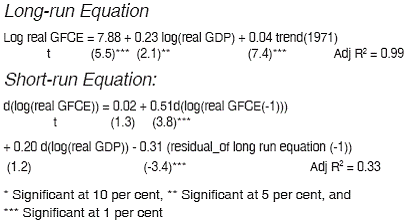 3.57 The results indicate that GFCE and GDP are co-integrated and that government spending is pro-cyclical both in the long-run and the short-run. However, for a shorter period (1980-81 to 2011- 12) the results are statistically insignificant. This may have been caused by counter-cyclical fiscal expansion undertaken in 2008-09 in the backdrop of global financial crisis. 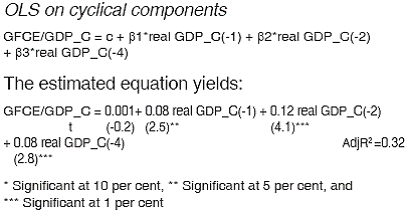 3.58 Since the coefficients of real GDP_C are found to be positive, government spending is again found to be pro-cyclical. The above results present evidence on the pro-cyclicality of government spending. This is further corroborated by the movements in clyclical component of GDP and GFCE (Charts III.9 & III.10). 3.59 Pro-cyclicality of fiscal spending in a developing economy is not unusual and empirical evidence is in substantial support of this, even though such behaviour defies common wisdom. Governments should borrow in “bad times” when revenues shrink and “social” spending rises, and repay debt in good times. However, fiscal policies do not smooth tax receipts and expenditures over the business cycle in EMDEs because of several reasons that include: (i) already stretched fiscal positions that leave limited space for counter-cyclical policies, (ii) insufficient provision in fiscal rules to support counter-cyclical policies, (iii) borrowing constraints faced by these economies, (iv) weak institutions that allow in-built deficit bias, (v) corruption that reduces the response of primary balance to output gap, (vi) voracity effect, wherein windfall revenue exacerbates the pressures for fiscal redistribution and accentuates the common pool problem. India is not devoid of such problems. VI. Debt-Deficit Dynamics and Monetary Management 3.60 The behaviour of deficit and debt may play a significant role in shaping monetary management, even though the central bank conducts debt management as an agency function of fiscal authority. Theoretically, monetary and fiscal policies interact in a number of ways to condition the short-run and long-run levels and the path of macroeconomic variables, such as output and inflation. This section analyses the interaction between debt-deficit dynamics and monetary policy in India during the past three decades. 3.61 Debt-deficit dynamics originate from the government’s decision to finance its expenditure through two alternative sources, viz., tax (plus non-tax and other non-debt receipts) financing and debt financing. The rollover of debt financing of government expenditure over the years in higher proportions may add to the stock of public debt even if the government is making regular repayments. In India, during the period 1980-81 to 2012-13, on average, one-third of the total government expenditure was financed by borrowing, i.e., for every `100 spent by the government, `33 were borrowed. 3.62 Despite the persistence of debt financing, its share witnessed a decline during the 2000s, reflecting the enactment of the Fiscal Responsibility and Budget Management (FRBM) Act, 2003 by the government, which brought about fiscal discipline in a gradual manner. Thus, the FRBM Act and the subsequent FRBM rules were milestones in the history of fiscal policy in India under which the government was legally required to achieve gross fiscal deficit of not more than 3 per cent of GDP by 2007-08, which was extended by a year to 2008- 09. In fact, the central government was ahead of the target when it was able to achieve a fiscal deficit-to- GDP ratio of 2.5 per cent in 2007-08. However, the declining trend in debt financing was reversed with the onset of the global financial turmoil as the government implemented fiscal stimulus programmes to offset the impact of the global slowdown on aggregate demand in the economy. 3.63 Thus, in recent years, i.e., 2008-09 to 2012- 13, the share of debt financing of expenditure has gone up. The moderate decline in the share of debt financing in the financial year 2010-11 reflected the impact of a partial exit from an expansionary fiscal policy, supported by strong growth in revenue receipts, including non-tax receipts, and recovery in economic growth. However, in 2011-12 and 2012- 13, the presistent low economic growth reduced the revenue resources of the government, and thus, expenditure fianancing through debt was slightly higher than in 2010-11 (Chart III.11). 3.64 The debt financing of expenditure entails a repayment obligation on the government, which according to the Ricardian equivalence will have to be financed by future tax and non-tax revenues. However, if the government is not able to raise adequate revenues in future to finance its past debt, it may have to resort to fresh borrowings to finance the old debt. This, in fiscal parlance, is popularly known as ponzi financing. Theoretically, to avoid this, the government has to generate a primary revenue surplus that is adequate to finance the interest payment obligations. In India, the central government has been running a primary revenue surplus for the past three decades except during recent years. However, during the past two decades, this primary revenue surplus was inadequate to finance the entire interest payments. With the implementation of the FRBM Act, when the government moved to a rule-based fiscal policy framework, the percentage of interest payments financed by primary revenue surplus witnessed an improvement in the fiscal arena. However, the fiscal stimulus programme with its expansionary mode eliminated the primary revenue surplus, and consequently the government reported a primary revenue deficit during recent years, which indicates that fresh borrowings were used to finance part of the interest payments (Chart III.12). 3.65 The implementation of the FRBM Act by the government played a major role in determining the level and path of fiscal deficit and debt in the Indian economy during the past decade. It is also argued in the literature that fiscal discipline is a mirror image of monetary independence. This is because while the amount of debt is the result of the fiscal policy of the government, the composition of debt is the result of debt management policy (Tobin, 1963). In many countries (including India), the debt management policy is vested with the central banks.2 While central banks do not generally have any control on the amount of deficit, large fiscal deficits often make it necessary that fiscal-monetary co-ordination is achieved to enable the smooth conduct of both monetary and debt management. Cross-country experiences suggest that this is either done through an institutional arrangement, where the co-ordination is achieved with the central bank conducting the debt management on behalf of the government, or by setting up a separate agency for debt management. The latter would nevertheless require a co-ordination mechanism that can become difficult in the case of large government market borrowings. As the latter has implications for interest rates, liquidity management and credit flows, an integrated view at one place has its own advantages. The amount of borrowing as an outcome of deficit, which is determined by the government, is exogenously given to central banks to arrange for its financing. Ipso facto, the standard theoretical arguments in the realm of fiscal-monetary interface rest on the interactions between debt management policy and monetary policy. Thus, the ways in which the deficit/debt is financed is as important as the size of deficit/debt. Further, given that the deficit/debt can be financed easily when its size is small, implies that fiscal discipline with commitment to bring down deficit/ debt will improve the manoeuvrability available to central banks while conducting monetary policy. External Financing of GFD and its Monetary Impact 3.66 Apart from being the monetary authority, in terms of Sections 20 and 21 of the Reserve Bank of India (RBI) Act, 1934, management of the public debt of the Government of India and the issuance of new loans is vested with the Reserve Bank of India. Further, under Section 21A of the RBI Act, the Reserve Bank may undertake the debt management of states, by agreements with the state governments. Thus, in India both the debt management policy and monetary policy are vested with the same institution. 3.67 As far as the financing of deficit is concerned, it is primarily financed through internal sources in India. During the past three decades, on average, 6.1 per cent of the total GFD in India was financed using resources raised through external sources. However, over the years, the extent of external financing of GFD declined. Further, although foreign institutional investors (FIIs) are allowed to invest in government securities, the government debt held by FIIs is only a small portion of the total government debt. The loans from multilateral and bilateral creditors are other sources of external financing. Moreover, the government has not directly accessed the international capital market as a sovereign entity. Thus, the usual risks associated with such borrowing has been practically absent (GoI, 2011). Such risks on soveriegn debt have exacerbated the crisis in the euro area. Further, in India, the sub-national governments are not allowed to raise external loans on their own. 3.68 Theoretically, the financing of GFD through external sources adds another dimension to the fiscal-monetary interface through the net capital inflows. According to the Mundell-Fleming open economy model, an independent monetary policy is impossible when there is intervention in the foreign exchange market to keep the exchange rate at tolerable levels (or at a fixed rate) in the context of huge net capital inflows often resulting in appreciation of the currency. Thus, financing the GFD through external resources at higher proportions can have repercussions not only on fiscal sustainability but also on the impossible trinity, i.e., open capital account, fixed exchange rate and independent monetary policy. The dependence on external finance for financing GFD has never been high and it has declined in the recent period, which is a welcome development in the Indian context. Importantly, from 2002-03 to 2004-05, the share of external financing turned negative, as high-cost external loans were pre-paid during this period (Chart III.13). Net Capital Inflows, Market Stabilisation Scheme and its Monetary Impact 3.69 During the 2000s, India built up significant foreign exchange reserves, indicating the absorption of a part of net capital inflows by the Reserve Bank during this period. Theoretically, the absorption of net capital inflows by the Reserve Bank creates reserve money, which through the multiplier effect leads to the creation of M3 in the economy. However, the reserve money as a ratio of GDP did not show any jump during this period, despite the absorption of high net capital inflows by the Reserve Bank. The Market Stabilisation Scheme (MSS) put in place by the Reserve Bank of India and Government of India in 2004, was used to sterilise the impact of foreign exchange market intervention thus, limiting the monetary impact of net capital inflows. The interest payments on MSS bonds are borne by the government. Thus, in the process of neutralising the monetary impact of net capital inflows, fiscal costs were incurred, leading to higher gross fiscal deficit. However, fiscal policy, in this process, increased the flexibility of monetary policy rather than constraining it. In fact, the MSS stands out as an example of effective fiscalmonetary co-ordination that not only helped in monetary contraction to offset the surges in capital inflows, but also in monetary expansion through the unwinding of the MSS after the global financial crisis set in motion an economic downturn. Internal Financing of Government Debt and its Monetary Impact 3.70 In India, more than 90 per cent of government debt is financed through internal sources. Theoretically, if the public debt is held domestically, then the risk of public debt is perceived to be low from the point of view of external sustainability. The recent experience of Portugal, Ireland, Greece and Spain, demonstrated that sizeable external holding of public debt has the potential to precipitate a sovereign debt crisis. From this viewpoint, the position of India is comfortable as the majority of India’s public debt is held domestically. However, if the domestically-held public debt is excessive, it is still subject to refinancing risks and has certain monetary impacts through the channels of interest rate, crowding out and monetisation. 3.71 Theoretically, higher fiscal deficit, by appropriating a higher share of total loanable funds in the economy, may push up interest rates for the private sector. The high interest rates may reduce private sector investment and finally result in a lower aggregate supply. A shift in the aggregate supply curve to the left implies that a new equilibrium between supply and demand would be associated with a higher price. Thus, the fiscal deficit through the crowding out effect may increase the price level in the economy with a corresponding reduction in the overall output. 3.72 According to Sargent and Wallace, the resultant tight money and interest rate conditions may lead to an unsustainable debt financing process and, thus, higher inflation in the long-run. In this framework, inflation is a fiscal-driven phenomenon, and nominal monetary growth is endogenously determined by the need to finance the exogenously given deficit to satisfy the budget constraint. 3.73 Further, if the monetary authority decides to offset the impact of higher interest rates by preventing crowding out of private investment, it may have to increase the money supply. This implies a rightward shift of the LM curve with a corresponding reduction in the interest rate and an increase in the output. However, if the economy is operating at near-full employment level, the increase in money supply may not result in an increase in output; rather it may push up the price level in the short-run as the short-run aggregate supply curve is vertical. 3.74 The different theoretical arguments outlined above rest on the financing of GFD through market borrowings. In India, the share of GFD financed by market borrowings has witnessed an increase over the past three decades. The reserve money as a per cent of GDP also witnessed an increase, at a lower rate, though inflation was lower in the last decade. Notably, during the past decade almost 74 per cent of the total GFD was financed by market borrowings (Table 3.2). The technical analysis to understand the dynamics of debt, deficit and money is attempted later. 3.75 As alluded to earlier, various institutional reforms relating to the link between debt management policy and monetary policy beginning 1996-97 have considerably improved monetary independence. 3.76 The monetisation issue, however, remains. Who ultimately finances government deficit depends not on who first subscribes to government securities in the primary market, but on who finally holds the government securities. In India, a portion of government securities is held by the Reserve Bank, and if this holding increases consequent to debt financing it leads to monetisation through secondary market operations. Thus, as Sargent and Wallace have pointed out, government deficits and debt will eventually be monetised over the long-run, resulting in reserve money creation. These issues were dealt with in detail in the earlier part of this chapter. 3.77 The relationship between debt-deficit dynamics and monetary management may also be affected by the wealth effect of government bonds (Kia, 2006). The proponents of the FTPL argue that in a non-Ricardian world, bondholders may not consider bonds as future taxes. Thus, as the government issues bonds to finance its deficit, the wealth of the nation is perceived to have gone up. This higher wealth effect may increase the demand for goods and services and may drive up prices in the short-run. 3.78 The theoretical possibilities outlined above are debatable, as the exact interface between fiscal and monetary policies will be conditioned by a number of factors in different country contexts. Thus, which theoretical relationship holds in a particular country depends on the macroeconomic priorities, political will, and other strengths and weaknesses of the economy. Some of the empirical evidence on the relationship between debt-deficit dynamics and monetary management is provided in Box III.5. Empirical Analysis 3.79 In the empirical analysis, the combined debt of the central and state governments was taken for the following three reasons: First, as alluded to earlier, it is the debt management policy that has implications for monetary management. Moreover, the implications of fiscal deficit may get reflected in the debt management policy, as debt is an accumulation of past deficits. Second, it is not only the first subscription of government securities in the primary market, but also the final ownership of government securities through the secondary market operations, that matters for monetary management. Thus, taking the combined debt of the government as an explanatory variable may capture these dynamics better than the fiscal deficit of the government. Third, the combined debt is used for the reason that the central government debt alone may not be the right variable for assessing the relationship between debt and reserve money, as the state governments have also accumulated substantial amounts of debt over the past decades. Further, like the central government, state governments also approach the market to finance their deficits. The securities issued by the state governments also have SLR status in India and their debt issuances are managed by the Reserve Bank. Thus, the implications of states’ debt for monetary management may be as important as the central government’s debt. 3.80 To empirically analyse the dynamics of the relationship between debt and money, an autoregressive distributed lag (ARDL) model is applied3. The first step in the ARDL bounds testing approach is to estimate the two equations by ordinary least squares: Box III.5 In the empirical literature, there have been several attempts to understand the relationship between fiscal and monetary policies in different countries, including India. Metin (1998) and Hamburger and Zwick (1981) found that monetary policy is strongly influenced by government expenditure rather than deficits. Tekin-Koru and Ozmen (2003) found no direct relationship between deficit and inflation in Turkey. According to this study, inflation in Turkey was also not a result of seigniorage; instead both money and inflation are jointly determined. Similar results are obtained by King (1985) in 12 countries, Joines (1985) for the U.S., Karras (1994) for 32 countries and Sikken and Haan (1998) for 30 developing countries. Giannaros and Kolluri (1985) found that, in general, the government budget deficit is not a determinant of money supply growth or of inflation, either directly or indirectly. The U.S. is an exception, with some statistical evidence of direct and indirect effects of the budget deficit on inflation. Using data for the 1954- 76 period, Barro (1978) concluded that it is government expenditure rather than deficits that influence monetary growth in the US. Using similar data, Niskanen (1978) found that government deficits do not have any significant effects on the inflation rate operating either through the rate of money growth or independent of it. Cagan (1965) argues that money supply exhibits both endogenous and exogenous properties. For short-run and cyclical fluctuations, Cagan proposed a relation in which the money supply is endogenously determined by changes in the real sector. However, in the long-run, secular trend movements in money supply are independent of the real sector and are determined exogenously. Parida, Mallick and Mathiyazhagan (2001) find that fiscal deficits and money supply are influenced by each other. Further, the price level does not influence either the fiscal deficit or money supply, but rather is being influenced by both the variables. Khundrakpam and Goyal (2008) in the Indian context find that money and real output cause prices both in the short as well as in the long-run. However, money is neutral to output. Further, the evidence shows that government deficit leads to incremental reserve money creation, even though the Reserve Bank financing of government deficit almost ceased to exist during most of the current decade. They argued that the government deficit, by influencing the level of sterilisation, impacts the accretion of net foreign assets to the Reserve Bank balance sheet and, therefore, continues to be a key factor causing incremental reserve money creation and overall expansion in money supply. Given the fact that money leads to inflation, government deficit remains relevant for stabilisation. Reference Khundrakpam, Jeevan K. and Rajan Goyal (2008), “Is the Government Deficit in India still Relevant for Stabilisation?”, Reserve Bank of India Occasional Papers, Vol. 29, No. 3: 1-21. 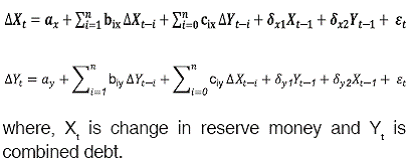 3.81 To test for the existence of a long-run relationship among the variables, an F-test for the joint significance of the coefficients of the lagged levels of the variables was conducted, i.e.,  The results were confirmed by a t-test on the coefficient of the lagged dependant variable, i.e.,  The results are provided in Table 3.3. 3.82 The existence of a long-run relationship between the variables was confirmed using both an F-test and t-test on the coefficient of the lagged dependent variable. The results of both tests indicate a co-integrating relationship between combined government debt and change in reserve money. The direction of causality is from combined government debt to change in reserve money4. The test for reverse causality was inconclusive with a significant F statistic and insignificant t statistic. Once long-run relationship is established, the second step is to estimate the long-run coefficients. The long-run relationship was estimated using the following equation. 3.83 The lag length of the model was determined based on Schwarz information criteria. The long-run coefficient of combined government debt on change in reserve money is estimated to be significant. The short-run dynamics of the relationship was captured by estimating an error correction model associated with the long-run estimates. The error correction model associated with this long-run estimate is provided below. The estimation results are provided in Table 3.4. 3.84 The error correction term obtained from the long-run relationship is negative and statistically significant, confirming the causality from combined government debt to change in reserve money. The speed of adjustment to equilibrium following a shock is quite high, with the coefficient of the error correction (EC) term at -0.99.
3.85 In this chapter, we presented anecdotal as well as formal empirical evidence that fiscal dominance on monetary policy remains to the extent that the monetary authorities have to modulate the use of various policy instruments keeping in view the financing requirements of fiscal deficit. However, the direct pressure on monetary policy has moderated as a result of institutional reforms that have been actively pursued in the area of fiscal as well as monetary management. Notwithstanding the improvement in fiscal-monetary frameworks, greater fiscal-monetary co-ordination would be needed in the times ahead. This co-ordination is important from the standpoint of inflation management, because, in the long-run, inflation leads to deterioration in the fiscal position as the expenditure response to inflation outstrips the revenue response. 3.86 The analysis in the chapter shows that on the whole government spending has been pro-cyclical. This pro-cyclicality of government expenditure can be accommodated if it is associated with a proportionate increase in revenue receipts, thereby keeping the fiscal deficit under check. In the absence of this, the pro-cyclicality of government expenditure could be risky, with higher fiscal deficit. This call for further institutional reforms to provide a more binding framework of fiscal rules that can withstand business and electoral cycles. 3.87 The empirical results also show that government debt granger causes reserve money growth in India, and the speed of adjustment to equilibrium following a shock is quite fast with a high adjustment coefficient. This causal relationship over the period 1982-2011 may reflect the monetisation of debt by the Reserve Bank up to 1997 through ad hoc treasury bills and through primary subscription to government debt untill March 2006. In the subsequent period, this impact may still have persisted on account of large OMO purchases. Such fiscal dominance is particularly detrimental to overall macroeconomic stability if it leads to reserve money growth above the desired level, which is required for broad money expansion consistent with economic growth and inflation. In this context, further attention would be required in designing institutional frameworks as well as practices. To conclude, an enduring reduction in fiscal deficits can further reduce fiscal dominance and enable monetary policy to play a more effective role. It is in this backdrop that the revised fiscal roadmap following the Report of the Committee on Raodmap for Fiscal Consolidation (Chairman: Dr. Vijay L. Kelkar) assumes critical importance. The raodmap envisages lowering the GFD-GDP ratio to 3.0 per cent by 2016-17. The fiscal adjustment roadmap on the revenue account perhaps needs to bring about a quicker adjustment. The implementation of a strict rule-based fiscal regime would imrpove fiscal-monetary co-ordination and facilitate the overall macroeconomic management. 1 Similar results were obtained by considering ‘Real GDP (at market price) excluding government spending’ as a variable instead of Real GDP (at factor cost). 2 For example, debt management is vested with the central banks in countries such as Sri Lanka, Kenya, Pakistan, Zambia, Costa Rica and Nicaragua. 3 ARDL was applied because of the different orders of integration of change in reserve money and combined debt. 4 However, it has to be kept in mind that the Reserve Bank can also alter reserve money through its liquidity adjustment facility, marginal standing facility and changes in cash reserve ratio, as has happened during recent years. |
|||||||||||||||||||||||||||||||||||||||||||||||||||||||||











